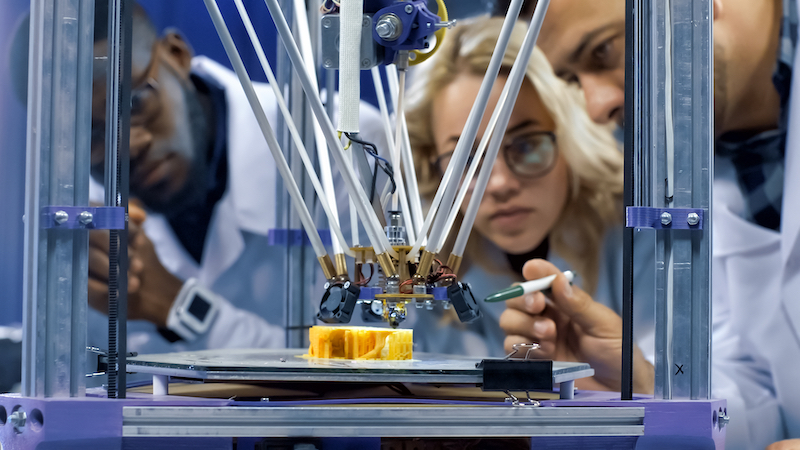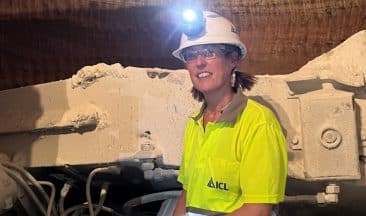Advanced materials (AdMs) are new materials with enhanced properties that are intentionally designed for superior performance. The major scientific advances of the 20th century, and a new understanding of atoms, laid the foundation for the creation of advanced materials. It’s the advances of the last three decades that have taken us over the conceptual threshold and are making advanced industrial materials a vital component of our high-tech economy.
Engineered materials are nothing new, and the creation of advanced materials does not represent a transformation in human ingenuity or design aspirations. Our Bronze Age ancestors experimented with alloys to improve the performance of base metals.
The combination of copper and tin created bronze, and the improved technology created new opportunities and design challenges. These in turn stimulated further technical development. The underlying curiosity about the nature of things, and how to manipulate them, has driven human development for thousands of years.
The process of primitive manipulation of molecular compounds continued in the Iron Age. 3,000 years ago, metallurgists discovered that the addition of carbon to iron, with the application of intense heat created steel. Shortly after, the Industrial Revolution introduced cheap mass production of higher-grade steel and a flood of technical innovations. The scientific developments of this period led to the discovery of atoms and an understanding of how materials function at an atomic level.
Advanced Materials in the 21st Century
21st-century innovations are allowing scientists to manipulate substances (inorganic and organic) at an atomic level and create new, purpose-built materials that massively outperform naturally occurring materials. We’ve seen a huge leap forward in the last three decades, leading to the successful integration of AdMs into high-tech manufacturing, medical procedures, and food production.
In real terms, we’re still on the bare threshold of a new technical revolution. It’s likely that the next twenty years will see a leap forward that surpasses the progress of approximately a century of the Industrial Revolution. The only real limitations are the laws of physics (as we currently understand them) and human imagination (as yet independent of AI).
What are Advanced Materials?
Advanced materials is a complex scientific topic that covers a huge variety of fields and applications. Advanced materials 101 defines advanced materials as a convenient generic term for any new material that has been deliberately created by human beings.
It’s generally used to refer to new materials, with high-tech applications, that were developed during the last few decades. Research and development of new advanced materials for industrial applications is multi-disciplinary and can draw on expertise in the fields of chemistry, physics, nanotechnology, ceramics, metallurgy, and biomaterials – to name a few.

The atomic revolution and advanced materials: the new age of materials engineering
The early 1900s saw an advance in the understanding of the physical nature of materials and the tiny atoms that are the building blocks of every physical substance. Advances in x-ray diffraction and the development of electron microscopy improved scientists’ understanding of how atoms are arranged.
Modern understanding of how materials behave at a macroscopic scale was transformed by the understanding of how they are arranged at the microscopic level. 20th-century scientists and researchers enthusiastically experimented with how to manipulate the arrangement of atoms – and how to split the atom.
Once fundamental atomic rules were understood by scientists, there was a potential to create entirely new materials. The design potential is (apparently) almost unlimited. Advanced materials and manufacturing encompass metals and inorganic materials, advanced mineral products, and organic materials. Organic processes include the manipulation and creation of cells and cell-like structures, DNA, and constituent proteins that are at the core of living organisms.
How advanced materials are changing our world
Advanced materials are beginning to transform every aspect of life. Previously immutable assumptions about the nature of raw materials and their industrial potential have been swept aside. Design and manufacturing industries were previously limited by the characteristics of naturally occurring raw materials, and the alloys and compounds we’d created from them. Our new capacity to create advanced materials from scratch is transforming design potential.
At a basic level, advanced materials 101 allows for improvements to existing products. An aircraft or a car can be made from stronger, lighter materials. It may last longer, run more economically, and be more friendly to the environment. Commonly used devices can become smaller and more efficient. A smartphone now performs many of the functions of a laptop, which in turn performs many of the functions of a computer that was once the size of a house.
Some life-changing innovations that depend on advanced materials and manufacturing research include:
- Integrated circuits
- Magnetic data storage
- Liquid crystal displays
- Fiber optics
- Lasers
At a truly innovative level, advanced materials are enabling the invention of entirely new products and devices. In theory at least, if anybody identifies a radical solution to an existing need, or defines a new concept, scientists will be able to invent brand new advanced materials to transform an idea into reality.
We may be at the point in human development where 20th-century science fiction becomes 21st-century reality. It’s worth noting that we’re already redefining our concepts of reality, with terms like virtual reality and augmented reality.
The Benefits of Advanced Materials
The general benefits of advanced industrial materials are straightforward. They have the potential to bring us cheaper, more sophisticated, and more user-friendly products. Household items, personal vehicles, and consumer durables are already improving our quality of life, saving labor, and enhancing recreation.
We are also seeing similar innovations in the workplace. Advanced industrial materials are revolutionizing the devices, systems, and infrastructures that previously defined and limited how we work and do business.
The reach and potential of businesses is expanding, as are methods of production, print-on-demand technology, emerging quantum computers, the harvesting and analysis of data, and the application of AI to design, monitoring, and problem-solving. Whether we realize it or not, our working lives are already dependent to an extent on advanced materials for industrial applications.
One of the greatest emerging benefits of advanced materials is the dramatic improvements to our most basic needs; good health and food security. The twentieth century delivered a revolution in medical care, more diseases became preventable or curable, and more (previously fatal) injuries became treatable than during any other period of human history. The next two decades will hopefully surpass these previous innovations on every conceivable (and previously inconceivable) level.
The combination of new advanced biomaterials, inorganic advanced materials, and tiny, AI-driven smart devices, will create a new generation of smart prosthetics that are effectively body part replacements. They will allow amputees almost perfect – or even enhanced – function. Previously fantastical ideas like organically grown or regenerated body parts, lab-grown retinas or internal organs, and regenerated skin for burns victims are all pushing toward conceptual validity.
We are already seeing nanotechnology applied to topical creams that contain advanced biochemical materials, as well as smart drugs that can be tailored for optimized individual therapy. Scientists can already manipulate cells, viruses, and organisms and the new technology is driving a transition towards personalized and preventative healthcare.
The global population is predicted to reach 9.5 billion by 2050. The human race faces the twin challenges of achieving the UN SDG of Zero Hunger while pushing toward Zero Carbon and environmentally sustainable agriculture.
Advanced materials and manufacturing can bridge that gap. Lab-created advanced biomaterials and proteins for human consumption, like 3D-printed meats, are another concept that is becoming commercially viable. New, nutritionally dense, healthy foods have the potential to disrupt the global food industry on a major scale. The advanced materials 101 for food production covers enough innovations to feed the world.
ICL and Advanced Materials
ICL’s rich mineral portfolio, range of high-tech enterprises, and commitment to innovation are a strong foundation for developing new advanced materials. ICL has access to physical resources, it continually overcomes design challenges, and has a corporate culture that encourages bold and unconditional thinking.
ICL has a proven commitment to sustainability and circular economy. We are currently meeting milestones on our own corporate roadmap towards achieving a zero-carbon state by 2050.
As of 2022, we are particularly interested in developing advanced materials in the field of inorganic phosphorus products and their applications for semiconductor, photovoltaic, and electronic flat panel displays. We are also focused on developing engineered materials to improve existing phosphate uses in pharmaceuticals, paints, and asphalt.
Other areas of interest for engineered minerals include the use of metallic magnesium alloys in the shift towards electric vehicles. These alloys are light-weight and have excellent strength and rigidity properties relative to their weight, making them ideal for use in both vehicles and electronics.
In nature, magnesium only occurs in a compound bound to other elements, such as the cubic magnesium oxide (magnesia), present in the mineral periclase. Magnesium plays a large part in ICL’s global business and we are keen to innovate with both engineered minerals and new devices and processes driven by advanced materials.
We are currently researching solutions to improve the availability of magnesium in drinking water via magnesia-enriched water. Agricultural aspects of magnesium R&D focus on using magnesia products as an anti-viral or as a barrier against bacteria and fungi and using magnesium as a post-harvest preservative for fruits.
ICL welcomes collaboration at all levels with anybody who has an original contribution in the field of engineered minerals and advanced materials, or sustainability and circular economy. We are keen to pioneer, develop and implement new solutions across all markets and have the vision and imagination to embrace unconventional thinking.






